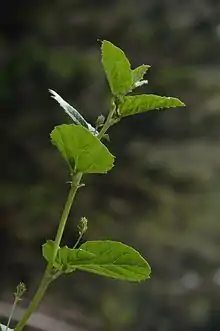Psoralea corylifolia
Psoralea corylifolia (Babchi) is a plant used in Indian and Chinese traditional medicine. The seeds of this plant contain a variety of coumarins, including psoralen.
| Psoralea corylifolia | |
|---|---|
 | |
| Scientific classification | |
| Kingdom: | |
| (unranked): | |
| (unranked): | |
| (unranked): | |
| Order: | |
| Family: | |
| Genus: | |
| Species: | P. corylifolia |
| Binomial name | |
| Psoralea corylifolia | |
| Synonyms | |
| |
Etymology
Psoralea is from the Greek psoraleos meaning 'scabby', and refers to small glands covering the plant. Corylifolia comes from similarity of the leaves to those of Corylus, a genus of tree in northern world regions, such as Sweden.[1]
Description
Psoralea corylifolia grows 50–90 cm tall and is an annual plant. It has pale-purple flowers in short, condensed, axillary spikes. Its corolla is pale purple. Flowers one-seeded fruits. The most distinctive feature is the occurrence of minute brown glands which are immersed in surface tissue on all parts of the plant, giving it a distinctive and pleasant fragrance.[2]
Habitat and distribution
P. corylifolia is native to India and Sri Lanka, and was occasionally cultivated in Arabia for its supposed medicinal properties.[3]
Chemical constituents
P. corylifolia extract contains numerous phytochemicals, including flavonoids (neobavaisoflavone, isobavachalcone, bavachalcone, bavachinin, bavachin, corylin, corylifol, corylifolin and 6-prenylnaringenin), coumarins (psoralidin, psoralen, isopsoralen and angelicin), meroterpenes (bakuchiol, and 3-hydroxybakuchiol).[4]
Use in traditional medicine
P. corylifolia L., or bu gu zhi in traditional Chinese medicine,[5] is an herb used as a supposed therapy for several disorders having limited clinical evidence, such as treatment of lichen-induced dermatitis by psoralen extract combined with sunlight exposure.[6]
References
- G. Miller, Anthony; Morris, Miranda (1988). Plants of Dhofar. Oman. pp. 174–5. ISBN 978-071570808-8.
- G. Miller, Anthony; Morris, Miranda (1988). Plants of Dhofar. Oman. pp. 174–5. ISBN 978-071570808-8.
- G. Miller, Anthony; Morris, Miranda (1988). Plants of Dhofar. Oman. pp. 174–5. ISBN 978-071570808-8.
- Zhao LH, Huang CY, Shan Z, Xiang BG, Mei LH (2005). "Fingerprint analysis of Psoralea corylifolia by HLPC and LC-MS". J Chromatogr B. 821 (1): 67–74. doi:10.1016/j.jchromb.2005.04.008. PMID 15905140.
- Cheng, Xia (2001). Easy Comprehension of Traditional Chinese Medicine: Chinese Materia Medica, Canadian Institute of Traditional Chinese Medicine, p343.
- Atzmony, L; Reiter, O; Hodak, E; Gdalevich, M; Mimouni, D (2016). "Treatments for cutaneous lichen planus: A systematic review and meta-analysis". American Journal of Clinical Dermatology. 17 (1): 11–22. doi:10.1007/s40257-015-0160-6. ISSN 1175-0561. PMID 26507510.